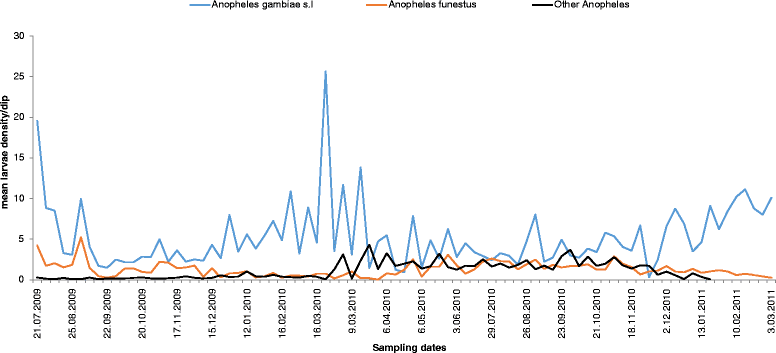Assessment of mosquito larval productivity among different land use types for targeted malaria vector control in the western Kenya highlands
- PMID: 26142904
- PMCID: PMC4491214
- DOI: 10.1186/s13071-015-0968-1
Assessment of mosquito larval productivity among different land use types for targeted malaria vector control in the western Kenya highlands
Abstract
Background: Mosquito larval source management (LSM) is likely to be more effective when adequate information such as dominant species, seasonal abundance, type of productive habitat, and land use type are available for targeted sites. LSM has been an effective strategy for reducing malaria morbidity in both urban and rural areas in Africa where sufficient proportions of larval habitats can be targeted. In this study, we conducted longitudinal larval source surveillance in the western Kenya highlands, generating data which can be used to establish cost-effective targeted intervention tools.
Methods: One hundred and twenty-four (124) positive larval habitats were monitored weekly and sampled for mosquito larvae over the 85-week period from 28 July 2009 to 3 March 2011. Two villages in the western Kenya highlands, Mbale and Iguhu, were included in the study. After preliminary sampling, habitats were classified into four types: hoof prints (n = 21; 17 % of total), swamps (n = 32; 26%), abandoned goldmines (n = 35; 28%) and drainage ditches (n = 36; 29%). Positive habitats occurred in two land use types: farmland (66) and pasture (58). No positive larval habitats occurred in shrub land or forest.
Results: A total of 46,846 larvae were sampled, of which 44.1% (20,907) were from abandoned goldmines, 30.9% (14,469) from drainage ditches, 22.4% (10,499) from swamps and 2.1% (971) from hoof prints. In terms of land use types, 57.2% (26,799) of the sampled larvae were from pasture and 42.8% (20,047) were from farmland. Of the specimens identified morphologically, 24,583 (52.5%) were Anopheles gambiae s.l., 11,901 (25.4%) were Culex quinquefasciatus, 5628 (12%) were An. funestus s.l. and 4734 (10.1%) were other anopheline species (An. coustani, An. squamosus, An. ziemanni or An. implexus). Malaria vector dynamics varied seasonally, with An.gambiae s.s. dominating during wet season and An.arabiensis during dry season. An increased proportion of An. arabiensis was observed compared to previous studies.
Conclusion: These results suggest that long-term monitoring of larval habitats can establish effective surveillance systems and tools. Additionally, the results suggest that larval control is most effective in the dry season due to habitat restriction, with abandoned goldmines, drainage ditches and swamps being the best habitats to target. Both farmland and pasture should be targeted for effective larval control. An increased proportion of An. arabiensis in the An. gambiae complex was noticed in this study for the very first time in the western Kenya highlands; hence, further control tools should be in place for effective control of An. arabiensis.
Figures
Similar articles
-
Anopheline larval habitats seasonality and species distribution: a prerequisite for effective targeted larval habitats control programmes.PLoS One. 2012;7(12):e52084. doi: 10.1371/journal.pone.0052084. Epub 2012 Dec 18. PLoS One. 2012. PMID: 23272215 Free PMC article.
-
Response of Anopheles gambiae s.l. (Diptera: Culicidae) to larval habitat age in western Kenya highlands.Parasit Vectors. 2013 Jan 16;6:13. doi: 10.1186/1756-3305-6-13. Parasit Vectors. 2013. PMID: 23324330 Free PMC article.
-
Spatial relationship between adult malaria vector abundance and environmental factors in western Kenya highlands.Am J Trop Med Hyg. 2007 Jul;77(1):29-35. Am J Trop Med Hyg. 2007. PMID: 17620627
-
Contributions of Anopheles larval control to malaria suppression in tropical Africa: review of achievements and potential.Med Vet Entomol. 2007 Mar;21(1):2-21. doi: 10.1111/j.1365-2915.2007.00674.x. Med Vet Entomol. 2007. PMID: 17373942 Review.
-
Bacterial larvicides used for malaria vector control in sub-Saharan Africa: review of their effectiveness and operational feasibility.Parasit Vectors. 2019 Aug 30;12(1):426. doi: 10.1186/s13071-019-3683-5. Parasit Vectors. 2019. PMID: 31470885 Free PMC article. Review.
Cited by
-
Larval habitat diversity, physicochemical characteristics and their effect on the larval density of malaria vectors in the city of Accra, Ghana.Res Sq [Preprint]. 2025 Apr 25:rs.3.rs-6362273. doi: 10.21203/rs.3.rs-6362273/v1. Res Sq. 2025. PMID: 40313773 Free PMC article. Preprint.
-
Mosquitoes of Etiological Concern in Kenya and Possible Control Strategies.Insects. 2019 Jun 16;10(6):173. doi: 10.3390/insects10060173. Insects. 2019. PMID: 31208124 Free PMC article. Review.
-
Aedes albopictus life table: environment, food, and age dependence survivorship and reproduction in a tropical area.Parasit Vectors. 2021 Nov 7;14(1):568. doi: 10.1186/s13071-021-05081-x. Parasit Vectors. 2021. PMID: 34743753 Free PMC article.
-
Larval habitat diversity, physicochemical characterization and their effect on the density of larval malaria vectors in the city of Accra, Ghana.Res Sq [Preprint]. 2024 Sep 20:rs.3.rs-4953028. doi: 10.21203/rs.3.rs-4953028/v1. Res Sq. 2024. PMID: 39372923 Free PMC article. Preprint.
-
Larval mosquito management and risk to aquatic ecosystems: A comparative approach including current tactics and gene-drive Anopheles techniques.Transgenic Res. 2022 Oct;31(4-5):489-504. doi: 10.1007/s11248-022-00315-9. Epub 2022 Jul 7. Transgenic Res. 2022. PMID: 35798930 Free PMC article.
References
Publication types
MeSH terms
Grants and funding
LinkOut - more resources
Full Text Sources
Other Literature Sources
Medical



